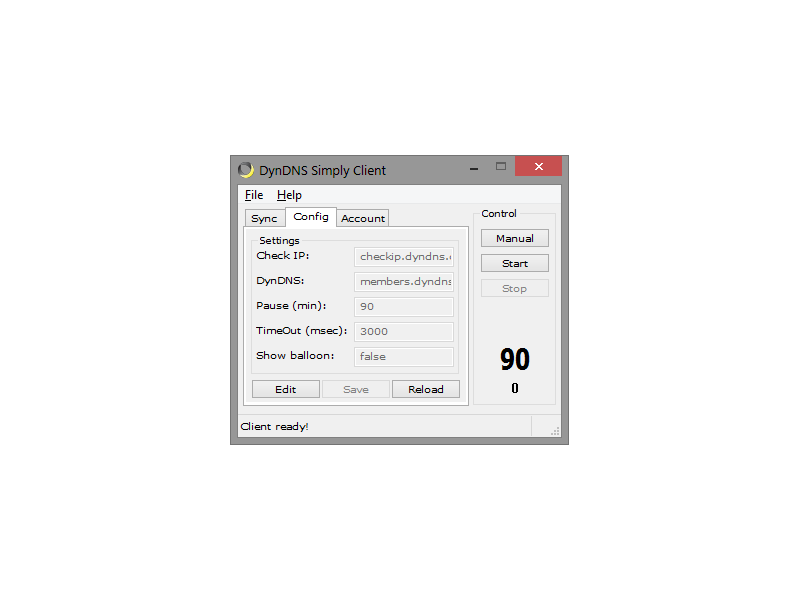
- DYN UPDATER CLIENT INSTALL
- DYN UPDATER CLIENT UPDATE
- DYN UPDATER CLIENT MANUAL
- DYN UPDATER CLIENT FULL
- DYN UPDATER CLIENT REGISTRATION
I have the updater client, and it works fine, updating the A Records as needed. In addition to the A record which I use to direct traffic to resources on my home network, I also have 2 TXT records in place so that my hotmail (now outlook or whatnot) email can be addressed using my custom domain email address. So I noticed today that my renewal for this service was only $5, and is now only renewed for a month. The updater is not updating my IP automatically. Further investigation shows this is because the Standard service is being retired.
DYN UPDATER CLIENT REGISTRATION
If you disable this policy setting, computers may not use dynamic DNS registration for any of their network connections, regardless of the configuration for. So I keep having to re-enter it manually on the DNS website. You can uninstall Dyn Updater from your computer by using the Add/Remove Program feature in the Windows Control Panel. There seems to be a little confusion about when it will be retired, but I see an official Oracle FAQ that says it is now May 31, 2022, so if that is true I have some time to figure this out. I am guessing that I will have to do month to month billing though, as that seems to be the only option.
DYN UPDATER CLIENT UPDATE
So my main question, what do I migrate to? I need the Dynamic ability to update using the update client (or whatever similar is needed), but I also need the TXT record for email.
DYN UPDATER CLIENT FULL
Looking at the documentation for DynDNS Pro, I'm not sure that it is full DNS, allowing the configuration of TXT records. An alternative to disabling dynamic update is to enable netmask ordering on the DNS server, which is described later. The DynDNS update log says it's been receiving updates, every 30 minutes, as configured. The other option seems to be the Oracle OCI DNS, but as far as I can tell, that would not support using the update client. &myipv6= (delete) or the Status column on the Dynamic DNS page says 'disabled', even though I edited and saved the configuration settings, and it didn't complain. Instead configure an address statically (or remove the address), you can addĪ the myipv6 parameter on the domain section, like this:
If you would like to avoid setting an IPv6 address automatically, and Set on your domain, even if you did not provide it explicitly. So, if you connect via IPv6, this address will be The update server is also considered when trying to find an IPv6 address toĪssign to your domain. IPv6 by replacing use with usev6, withĬ, and with .Īccording to Determine IP Addresses, the IP used for connecting to Note 1 Exclusively on Debian and derivatives, since ddclient 3.8.2-3 you can enable io login = password = '' įor more information, check out these two sections of the ddclientĭocumentation. Protocol = dyndns2 # "use=cmd" and the curl command is one way of doing this other ways exist use = cmd, cmd = 'curl ' ssl = yes server = update. So otherwise, your credentials will be exposed during transmission.

Note: As of the time of this writing, ddclient does not use an encrypted Last, tell ddclient how toĭetect your IP address, your domain name and the update interval. The token secret that you received during registration. The “dyndns2” protocol to perform updates. In the configuration process, select “other” dynamic DNS service provider, andĮnter as the dynamic DNS server. If a configurationĭialog does not appear automatically, use sudo dpkg-reconfigure ddclient to
DYN UPDATER CLIENT INSTALL
To install ddclient, run sudo apt-get install ddclient. Note that depending on the ddclient version you are using, IPv6

With the ddclient package, you can use it to update your IP address with our If you’re on Debian, Ubuntu or any other Linux distribution that provides you
DYN UPDATER CLIENT MANUAL
To find out the placeholder namesįor your router, please refer to the manual of your device.Īutomatic configuration (Debian-/Ubuntu-based systems) ¶ With the IP addresses replaced by placeholders. To be configured with an update URL that provides both IP addresses via query string To update both your IPv4 and IPv6 address at the same time, most routers need To set up IPv4 and IPv6 by using both update servers in an alternating fashion. Why that is the case, see Determine IP Addresses.) It is not possible The DNS, and your domain will operate in IPv6-only mode.

Note that when using this update server, your IPv4 address will be deleted from Modify the “Update Server” or “Update URL” setting in your router’s If it does not, you can try to let our servers determine your There is a chance that your router already properly supports pushing its IPv6Īddress to us.


 0 kommentar(er)
0 kommentar(er)
